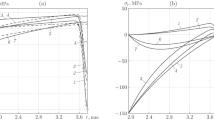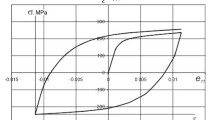Abstract
The stress-strain state of a material in hardening is calculated for a solid cylinder as an example on the basis of the theory of thermoplasticity with the use of the associated flow law and the Mises criterion. The microscopic inhomogeneity of the medium caused by structural and phase transformations is represented schematically by a structural model in correspondence with which each phase is considered as a continuous medium with boundaries moving in the course of the phase transformation or under the action of a force.
Similar content being viewed by others
References
I. A. Borisov, “Heat treatment of critical parts in machine building,”Metalloved. Term. Obrab. Met., No. 9, 2 – 6 (1979).
T. Inoue, S. Nadaki, T. Kishino, and M. Monkawa, “Description of transformation kinetics, heat conduction and elastic-plastic stress in the course of quenching and tempering of some steels,”Ingennicur Archiv,50(5), 315–327 (1981).
N. I. Zagryatskii and T. P. Vmogradova, “Investigation of the stress-strain state in quenching,” in:Thermal Stresses in Parts of Stnuctures [in Russian], Issue 20, Naukova Dumka, Kiev (1980), pp. 90 - 94.
N. I. Zagryatskii, “Calculation of the stress-strain state in quenching,”Prikl. Probl. Prochn. Plastichn., 111 – 119 (1980).
N. I. Zagryatskii, Yu. G. Korotkikh, and T. P. Vmogradova, “Calculating the kinetics of the stress-strain state in quenching with allowance for phase transformations,” in:Creep in Structures: Abs. Rep. All-Union Symp. [in Russian], Izd. DGU, Dnepropetrovsk (1982), pp. 65 - 66.
H. Buchler, H. Buchholtz, and E. Schultz, “Eigenspannungenbei der Warmebehandlung vom Stahl,”Archiv Eisenhuttenwesen, Gruppe E. S., 413 – 418 (1932).
A. A. Popov and L. E. Popova,Isothermal Thermokinetic Diagrams of Decomposition of Supercooled Austenite [in Russian], Metallurgiya, Moscow (1965).
N. I. Bezukhov, V. L. Bazhenov, I. I. Gol'denblat, et al.,Calculation of Strength, Stability, and Vibrations under High Temperatures [in Russian], Mashinostroenie, Moscow (1965).
B. A. Apaev, N. I. Zagryatskii, and B. F. Galkin, “Calculation of the stress-strain state in hardening and electric discharge treatment,” in:Abs. Rep. Conf on the Theory and Practice of Rapid Deformation of Met. Mater. (Mogilev, 19 - 21 Nov. 1974) [in Russian], Minsk (1974), pp. 9 – 10.
D. K. Bower, F. M. Capus, and C. E. Silverstone, “Plastic flow martensite,”Philosophical Magazine,15(137), 1041 - 1044 (1967).
F. L. Aston, "“The influence of tempering-time on some of the mechanical and physical properties of steel,”J. Iron Steel Inst.,192(4), 510 - 517 (1959).
Ya. B. Fridman,Mechanical Properties of Metals [in Russian], Masinostroenie, Moscow (1974).
L. V. Petrash,Quenching Media [in Russian], Mashgiz, Moscow - Leningrad (1959).
Author information
Authors and Affiliations
Additional information
Translated from Metallovedenie i Termicheskaya Obrabotka Metallov, No. 9, pp. 30 – 34, September, 1996.
Rights and permissions
About this article
Cite this article
Zagryatskii, N.I., Vinogradova, T.P. Hardening kinetics of the stress-strain state of a cylinder made of steel 45. Met Sci Heat Treat 38, 399–403 (1996). https://doi.org/10.1007/BF01395647
Issue Date:
DOI: https://doi.org/10.1007/BF01395647




